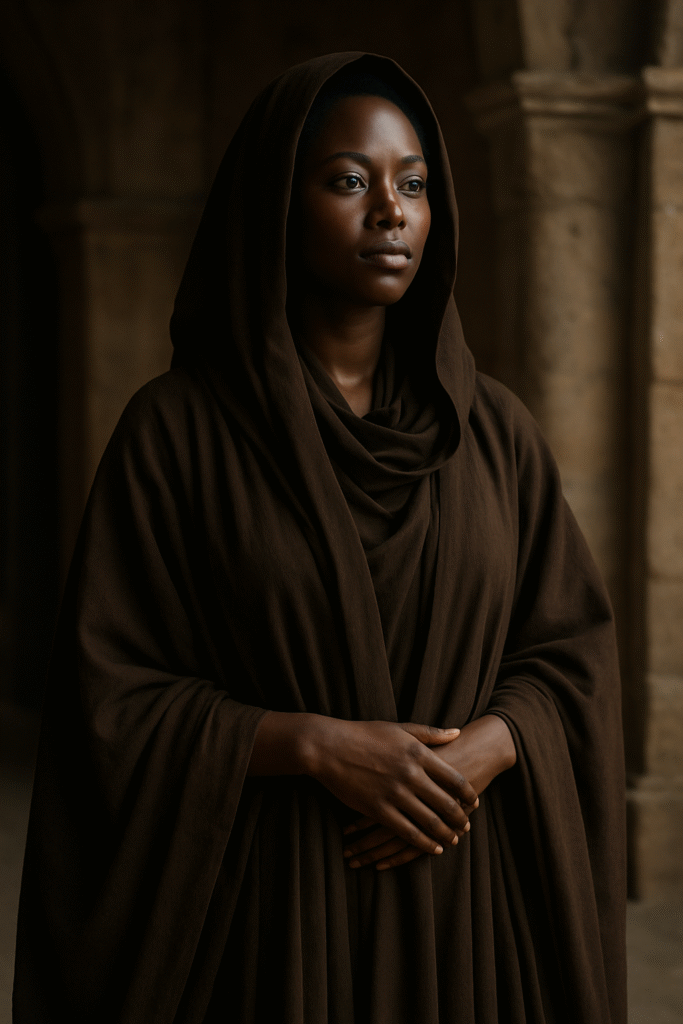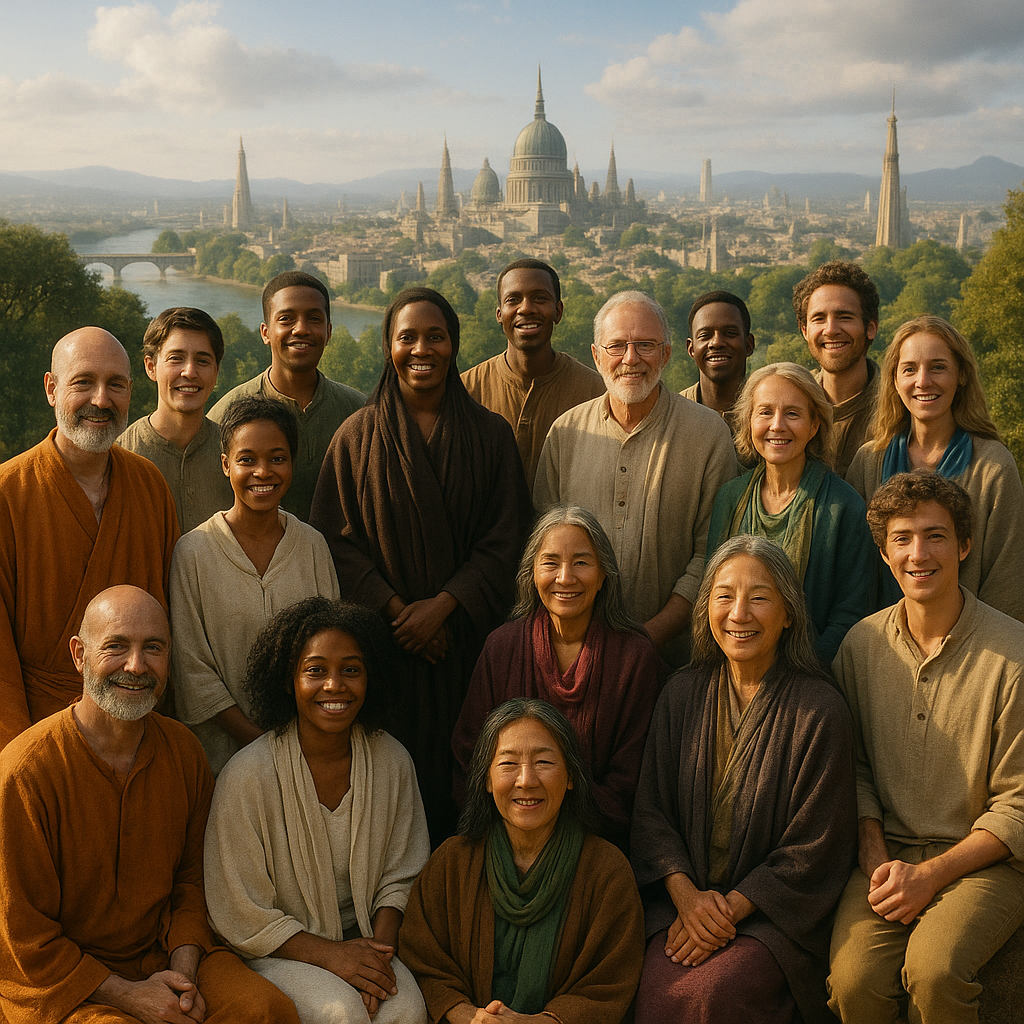THE PHILOSOPHY OF CENTEREDNESS When we speak of the Centered Cross in the Unitive Way, we’re not referring to a mere symbol. We’re pointing toward a map of wholeness—a sacred geometry of the soul. Its four arms—Transcendence (upward), Immanence (downward), Communion (leftward), and Agency (rightward)—invite us into a spiritual life that is not one-directional, but multidirectional. We walk upward...

A RADICAL PATH OF FREEDOM & FULFILLMENT FOR EVERYONE
At its heart, the Unitive Way recognizes that the great spiritual journey doesn’t lead us away from the world, nor does it abandon us to it. It leads us through the world, into a deeper intimacy with life as it is—breath by breath, body and soul, shadow and light. It begins with the insight that what we are searching for is already within us, already present in our experiences of love, longing, grief, and beauty. The path is not toward something else, but into everything more fully.
The Unitive Way is not a new religion, but it may feel like a new spiritual path for those who have wandered far and wide in search of meaning. It speaks especially to those who find themselves at the edges: mystics without monasteries, queers without churches, seekers without creeds. It is a way of seeing and living that dares to claim that unity is not an abstract ideal but a living, embodied truth. It offers a spiritual home for the so-called “nones”—those who check “none of the above” on surveys about religion but still yearn for depth, connection, and meaning.
The Unitive Way is not for the faint of heart. It asks for everything, not by force, but by invitation. It does not demand belief in any one deity, doctrine, or institution. What it does ask is your presence—your fierce, fragile, embodied presence. It welcomes the artist, the lover, the activist, the addict, the doubter, and the devotee. It honors the whole self and the whole world.
Freedom here isn’t escape. It’s presence. Fulfillment isn’t perfection. It’s wholeness. To walk the Unitive Way is to commit to your own becoming—not in isolation, but in communion with the world and with Spirit. It’s to risk being fully alive. And in that risk, we discover the truth: that nothing needs to be added to our lives for them to become holy. We only need to see—and dare to live—the unity that has always been.

The Centered Cross: A Symbol of The Unitive Way
The core symbol of the Unitive Way is the Centered Cross. Unlike the traditional Christian cross or Catholic crucifix, which may evoke suffering or sacrificial atonement, the Centered Cross expresses a radically embodied concept of human nature. It reveals a spiritual topology in which transcendence and immanence, agency and communion, are held together in tension and harmony. It is a compass and a mirror.
At the heart of the cross is the Center: the unshakeable still point from which all movement radiates and to which all movement returns. From this Center extend four lines with arrow tips:
The Upward-Facing Line: Transcendence
The upward line represents the movement of transcendence: the soul’s longing to go beyond, to reach toward Spirit, to lift the heart into the heights of possibility. It is the movement of prayer, of aspiration, of self-transcendence. It is the yearning for more.
This line resonates deeply with Eros—not just in its sexual form, but as the archetypal drive toward union with what is beyond us. In psychological and spiritual terms, this upward pull is aligned with heterophilia: the attraction to the “other” in its many forms. It energizes the path of growth by inviting us to fall in love with difference, to be drawn toward what we do not yet possess.
The Downward-Facing Line: Immanence
The downward line represents the movement of immanence: the descent into the here-and-now, the body, the Earth, the ordinary and sacred details of life. It is the movement of embodiment, of grounding, of presence.
Here we find the parallel with Agape—the love that sees and honors what is, as it is. As articulated in Soulfully Gay, self-immanent love is the current of homophilia: not attraction to the “other,” but the recognition and reverence of the “same.” It is the honoring of what already is. This current is especially powerful for those who experience same-sex love, and in the Unitive Way it is not viewed as a deviation but a revelation. Homophilia discloses the holiness of sameness, the divinity of self-recognition in the beloved.
The Left-Facing Line: Communion
The leftward line extends toward communion: the movement of relationship, connection, and participation in community. It is the feminine pole of being, not because it belongs to women, but because it represents the archetypal pattern of receptivity, nurture, and mutuality.
In this vector we find the social self, the one that seeks belonging and resonance. It is where our wounds are held and healed in relationship. The line of communion links to the collective, the societal, the intersubjective. The leftward movement honors the face of the neighbor, the cry of the oppressed, the joy of mutual support. It insists that we are not islands. It is the dimension of spiritual sisterhood, cultural ecology, and radical empathy.
The Right-Facing Line: Agency
The rightward line reaches toward agency: the movement of will, individuality, and differentiation. This is the masculine pole of being, not because it is limited to men, but because it expresses the archetypal energy of assertion, creation, and direction.
Agency is where we risk action. It is where the artist picks up the brush, the activist grabs the megaphone, the seeker steps into the unknown. It is deeply personal, even lonely. And it is also holy. In this movement, the self becomes real—not in opposition to others, but in harmony with the Center. The masculine archetype here is not dominance but presence, not control but conscious action.
Taken together, the four lines of the Centered Cross form a map of human nature. Not a static picture, but a dynamic invitation to live at the intersection of all four: rooted in the body, reaching for the heavens, connected to others, and acting with integrity. This is what it means to walk the Unitive Way.

The Philosophy of the Unitive Way
To fully appreciate the power of the Unitive Way, we must go beyond metaphor and explore the philosophical vision that undergirds it. The Unitive Way offers an integrated approach to ontology (what is), epistemology (how we know), and ethics (how we live). Each aspect affirms the fundamental unity at the heart of reality while honoring diversity, complexity, and depth.
The Ontology of The Unitive Way
Ontology asks: What is ultimately real? For the Unitive Way, reality is not dualistic—not a split between spirit and matter, good and evil, self and other. Instead, reality is One: a seamless whole appearing as multiplicity. The world is not fallen; it is fractured only in our perception. The truth is unity. The Cross is centered because being itself is centered.
This does not mean all distinctions vanish. It means distinctions are held within a greater whole. Light and shadow, male and female, eros and agape—these are not opposites but complements. The universe is not at war with itself. The divine is not elsewhere. God is not an escape from life but the secret pulse within it.
The Epistemology of the Unitive Way
How do we know what is true? Our view of enlightenment is not as a final destination or escape from life, but as an ongoing, embodied realization—a deepening capacity to see clearly, act wisely, and love fully from the Center. The Unitive Way proposes that knowledge of reality is not merely mental. It is embodied, relational, and participatory. We know by being, by becoming, by loving. Truth is not an object to be grasped but a relationship to be entered.
In the Unitive Way, we affirm multiple ways of knowing: rational, intuitive, aesthetic, ethical, mystical. Each way of knowing is like a line extending from the Center. No one mode is complete without the others. When we live in unity, we trust the truth of our body, the insight of our heart, and the vision of our spirit.
This inclusive epistemology does not reduce truth to mere subjectivity. It calls for discernment, humility, and intersubjective validation. But it refuses to exile feeling, beauty, or direct experience from the domain of knowledge.
The Ethics of the Unitive Way
How then shall we live? Ethics in the Unitive Way is not about rigid rules or abstract duties. It is about alignment. When we live in harmony with the Center—when our actions embody and integrate transcendence and immanence, agency and communion—we begin to live ethically.
This ethic is grounded in awareness and presence. We become more ethical not by obeying external authority, but by becoming more aware, more compassionate, more integrated. The Center becomes our compass. Love becomes our law. And unity becomes our aim.
This doesn’t mean moral relativism. Some actions pull us away from the Center. Others return us to it. But the test is not dogma. The test is embodiment: Are we living as whole beings in a whole world? Are we responding to life with love and responsibility? Are we walking the Way with others?

Sources of the Unitive Way
The Unitive Way does not arise in isolation. It stands on the shoulders of many traditions, weaving together spiritual insights from nondualistic philosophy, integral theory, archetypal psychology, and more. In this section, we explore the key streams of wisdom that help illuminate its foundations and practical implications.
The Unitive Way began with Joe Perez’s lifelong effort to make sense of The Great Scheme of Things through autobiography, integrative philosophy, and nondual spirituality. It isn’t a proprietary doctrine, but a gift—offered in gratitude for the wisdom he received from mentors, teachers, and sacred traditions. Drawing from contemplative Christianity, nondual Buddhism, Integral Theory, depth psychology, and queer spirituality, the Unitive Way reflects a tapestry of insights. While Joe’s voice is central, he claims no exclusive authorship—only the role of remembering and refining a pattern of wholeness, offered freely to others.
Nondual Wisdom
In contrast to many contemporary nondual teachings that emphasize the realization of enlightenment as a final attainment, the Unitive Way offers a grounded approach to nonduality—one that integrates awakening with ethics, personal growth, and embodied healing. Drawing especially from Nondual Recovery, we interpret addiction and avoidance not as moral failings or mere psychological issues, but as distorted expressions of two fundamental spiritual drives: freedom and fulfillment.
Addiction arises when the impulse toward freedom becomes disconnected from wholeness. Avoidance appears when the desire for fulfillment retreats from presence. Both are attempts to escape the pain of fragmentation. In The Unitive Way, we don’t just recognize our true nature as awareness; we learn to live from it in daily life. This means facing the aspects of our life that bedevil us—not with judgment, but with compassion. In doing so, we realign distorted expressions of self with their luminous origin in nondual being.
The Unitive Way includes the Twelve Principles and Twelve Tenets of Nondual Recovery as practical guides for nondual living. These frameworks support integration rather than separation as indistinct from Realization. The Principles orient us toward the paradoxes of awakening, while the Tenets offer relational and communal wisdom grounded in presence and honesty. Together, they show that awakening isn’t an escape from life, but a path of healing it through loving awareness.
Integrative Wisdom
Ken Wilber’s Integral Theory—and other integrative metatheories—offer a remarkably nuanced map of human development, cultural evolution, and spiritual realization. These frameworks bring powerful insight into how individuals and societies grow and mature. Yet for many seekers, such models can feel overly abstract, technical, or intimidating. The Unitive Way draws deeply from Integral Theory, but seeks to bring it down to earth—into the soil of everyday life, relationships, and embodied practice.
We treat evolution not merely as a cosmic principle, but as a lived ethos: a daily invitation to grow, wake up, clean up, show up, and open up—held in dynamic tension with the parallel call to remember, let go, root deep, dissolve, and heal. This rhythm of ascent and descent corresponds to the sacred geometry of the Centered Cross: upward toward transcendence, downward toward immanence. We do not privilege one direction over the other. As we cultivate spiritual maturity, we begin to embody a kind of living omnidirectionality—a skillful flow between the dimensions of human life that welcomes every movement of the Spirit.
Integral awareness also insists that personal transformation cannot be isolated from cultural and collective transformation. The Unitive Way regards spiritual development as a relational process that calls us into community, creativity, and compassionate service. Integral consciousness invites us to hold complexity without collapsing into confusion; to honor many viewpoints while remaining anchored in the Center. The Unitive Way is neither strictly political nor apolitical—it transcends partisanship without ignoring the realities of justice, power, and liberation. It encourages action informed by wisdom, and wisdom shaped by love, in service of a world where transformation is not the privilege of the few, but the birthright of all.
Soul Journeys
Additionally, the Unitive Way honors the language of the soul—archetypes, myths, dreams, symbols, and rituals. These are not mere psychological ornaments or poetic flourishes; they are sacred maps for the journey of spiritual integration. Drawing on Jungian-inspired psychology and other transpersonal approaches, the Way invites practices such as ritual, psychodrama, dreamwork, journaling, and vision quests. These embodied tools help us root ourselves in the lived experience of body and emotion, affirm the dignity and depth of life, and keep us attuned to our essential interconnection with the rhythms and patterns of the natural world.
The Unitive Way would be incomplete without a deep commitment to shadow work—the inner discipline devoted to healing wounded aspects of the psyche and reclaiming lost or repressed energies for transformation. Shadow work is not about fixing what is broken, but about integrating what has been denied. Practices such as depth psychology, contemplative journaling, intersubjective mirroring, facilitated psychodrama, and nature-based rites of passage serve as portals into this healing process. Vision quests and symbolic encounters with the unconscious can reveal that our shadows are not enemies to be conquered but allies in disguise—keepers of our buried power and wholeness.
Spiritual integration, in this vision, is not about ascending into an idealized self but becoming fully present in the truth of who we are. Archetypes such as the Warrior, the Healer, the Lover, and the Sovereign accompany us through life’s initiations, offering guidance in times of conflict, compassion, desire, and discernment. Equally important are the archetypes of the Inner Feminine and Inner Masculine, as well as the Inner Homophile and Inner Heterophile—each illuminating vital dimensions of gendered and erotic being. These archetypal energies help us recognize ourselves in the full spectrum of human nature, offering both challenge and invitation on the soul’s unfolding path.
Real Magick
Emerging from within the Unitive Way is a bold new esoteric path known as Integral Magic—a synthesis of sacred space, sacred time, and mystical language. It is not merely a repackaging of past traditions, but a living system that integrates ancient wisdom with contemporary insight. Through symbolic acts and ritual practices, Integral Magic opens portals into spiritual dimensions where inner transformation aligns with cosmic patterns. Soul work becomes more than therapeutic—it becomes cosmological, inviting us to see our healing as part of the healing of the world.
At the heart of this approach is a renewed appreciation for the power of symbol and story. Poetry and scripture, chant and silence, image and icon—all serve as vehicles of meaning and transmission. The Unitive Way affirms both the enduring value of classical works and the importance of newly revealed texts, songs, and visual art offered by contemporary practitioners. These living revelations aren’t distractions from tradition—they are its continuation. Art becomes a discipline of integrative nonduality, a way of drawing beauty down from the subtle realms into the everyday.
Among the most distinctive practices of Integral Magic is the use of Lingua-U, a new system of inspired metalanguage. Designed to bring the world’s Sacred Word traditions—such as Sanskrit, Hebrew, Arabic, and Greek—into phonosemantic harmony, Lingua-U reveals the hidden architecture of language itself. It treats the vibrations of vowels and consonants as spiritual gateways, capable of guiding the practitioner toward deeper Self-realization and intimacy with the Divine. Not all who walk the Unitive Way feel called to chant its mantras or explore its subtle metagrammars, but for those with ears to hear, Lingua-U is a language of initiation—a luminous thread that weaves through the Mystery and leads one home.

The Unitive Way and Religion
The Unitive Way is a trans-religious path (sometimes called a trans-path path or interspirituality) that welcomes insight from the world’s Great Wisdom Traditions—so long as they contain streams of wisdom congruent with (or which can be transfigured into being congruent with) the Unitive Way with its symbols, philosophy, and core tenets. This is not a random blending, but an integrative approach that honors diverse spiritual expressions while inviting all into a shared path of awakening, healing, and love from the Center.
Nondual Buddhism
Buddhism offers rich ground for the Unitive Way. Mahayana, Vajrayana, and Zen all convey nondual insights, especially through the concept of śūnyatā (emptiness), which (like Christianity) mirrors the Eros pole of the Eros/Agape polarity. Practices such as Dzogchen’s spontaneous presence, Zen’s embodiment of suchness, and the bodhisattva path of compassionate wisdom align with the Way’s vision of liberation.
Buddhist teachings illuminate how liberation is not found in escape from the world, but in penetrating its very nature—realizing that the forms of experience are empty, and that this emptiness is luminous, compassionate, and awake. The Unitive Way values this paradox and incorporates it into its own understanding of transcendence, seeing emptiness not as negation, but as the spacious ground in which all things arise. In this way, Buddhist contemplative disciplines become tools for deepening awareness of the Center and dissolving attachment to false identities.
Contemplative Christianity
While it doesn’t require belief in any one faith, the Unitive Way honors contemplative Christianity—especially Centering Prayer, which attunes awareness to the presence of the Divine in all things. Traditional Christianity often leans toward transcendence, the Eros pole in the Eros/Agape polarity, but its mystics and outstanding theologians—like Meister Eckhart, Julian of Norwich, and Teilhard de Chardin—offer a fuller vision that is inclusive of divine immanence. The Unitive Way echoes this vision, seeing Christ as an archetype of integrated being: fully divine and fully human, transcendent and immanent.
This Christic vision finds resonance in the Centered Cross of the Unitive Way, where the vertical axis symbolizes both the soul’s upward yearning for God and the descending grace of Spirit into flesh. Christian mysticism, especially in its apophatic (via negativa) mode, recognizes the mystery of God as beyond all images and doctrines—a mystery that can only be met through surrender and silence. The Unitive Way reclaims this silence not as emptiness, but as fertile stillness where presence and transformation unfold.
Harmony with Great Spirit
Nature-based religions—Indigenous cultures, neo-pagan circles, or the Radical Faeries—emphasize the Agape pole of the Eros/Agape polarity. These paths elevate the sacredness of what is—of earth, body, relationship, and presence—rather than aspiring to transcend it. Through seasonal rites, ancestral reverence, elemental rituals, and celebrations of life’s cycles, they root spiritual practice in the soil of embodied existence. They offer essential balance to transcendence-oriented paths and help ground the Way in a spirituality that embraces nature as teacher, kin, and sacred text.
For the Unitive Way, such paths offer not only ecological and relational wisdom, but also vital rites of embodiment—reminding us that healing and transformation are not solely inward journeys, but lived enactments in rhythm with the land and community. In honoring the elements, seasons, and spirits of place, nature-based religions help us remember that the divine is not confined to heaven or self, but revealed in rivers, trees, stones, and stars. Their gift is reverence for what is already here.

Living the Unitive Way
The Unitive Way is not merely a philosophy or a set of ideas. It is a practice of becoming. A return to presence. A letting go of the illusion of separation.
To walk the Way is to recognize the sacred in the self and in the world—not in theory, but in practice. It is to discover, again and again, that we are already home. That our lives, as they are, can become vessels of grace and grit.
And so we walk: upward, downward, outward, inward. Each step a revelation. Each breath a prayer. Each soulful moment an opportunity to live the unity that has always been.
If these words resonate, consider them an invitation. The Unitive Way welcomes all who seek to live from the Center and embody love in action. Find likeminded companions. Gather in small circles. Create sacred space for realization, healing, and joy. You are not alone on this path—and the world is waiting for what only you can bring.
By Joe Perez
Seattle, Washington
May 16, 2025
